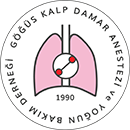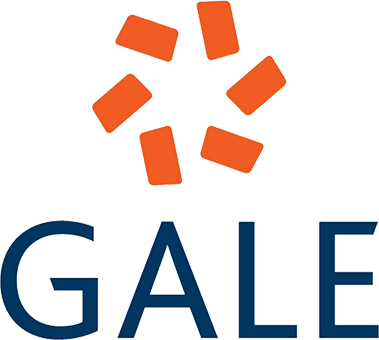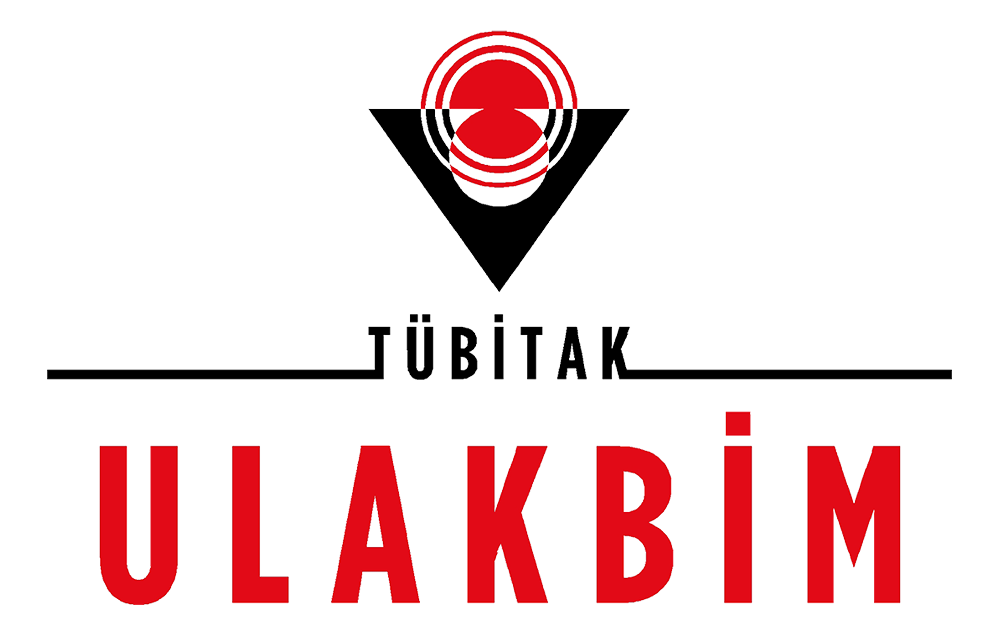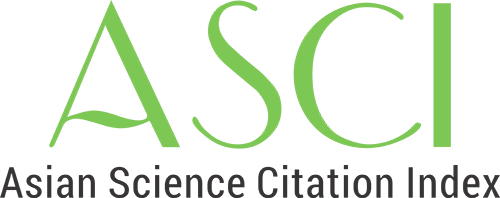
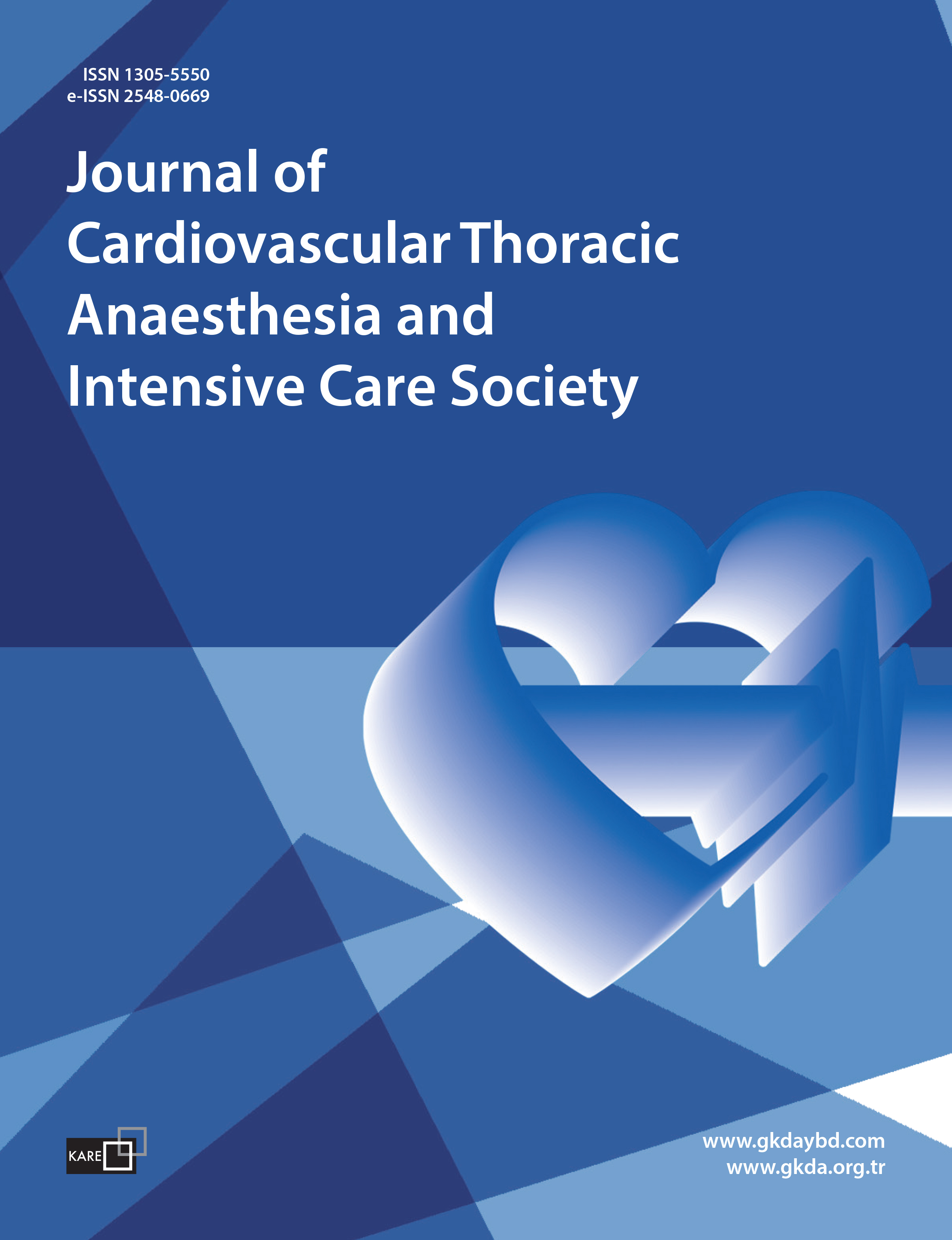
Volume: 22 Issue: 4 - 2016
| REVIEW | |
| 1. | Management of Cardiac Arrest in Pregnancy Berrin Günaydın, Lawrence C Tsen doi: 10.5222/GKDAD.2016.131 Pages 131 - 137 (1327 accesses) Gebelerde tahmin edilen sıklığı 20 000de 1 olan kardiyopulmoner arrest, nadir gibi görünse de her an olabilir. Bu nedenle klinisyenler hızla cevap vermeye hazırlıklı olmalıdır. Maternal resüsitasyon, gebeliğin anatomik ve fizyolojik değişikliklerine bağlı çok küçük ayarlamalarla gerçekleştirilir. Anesteziyologlar, obstetrisyenler ve neanatologlar hem anne hem de yenidoğan için uygun tedaviyi sağlamak için takım olarak çalışmalıdırlar. Bu derleme makale, gebelikte kardiyak arrest yönetimini ve perimortem sezaryen kullanımı sunmaktadır. Cardiopulmonary arrest, which is seemingly uncommon with an estimated incidence of 1 in 20,000 pregnant women, can occur at any time. Therefore, clinicians should be prepared to respond immediately. Maternal resuscitation is performed with only a few minor adjustments due to the anatomic and physiologic changes of pregnancy. Anesthesiologists, obstetricians and neonatologists should work as a team to ensure appropriate treatment of both mother and newborn. This review article will address the management of cardiac arrest in pregnancy and the use of perimortem cesarean delivery. |
| EXPERIMENTAL WORK | |
| 2. | Comparision of Different Sedative Protocols for Patients Undergoing Carotid Surgery Meltem Savran Karadeniz, Ömür Aksoy, Nükhet Sivrikoz, Fatma Demircan, Ömer Sayın, Zerrin Sungur, Nüzhet Mert Şentürk doi: 10.5222/GKDAD.2016.138 Pages 138 - 144 (1232 accesses) GİRİŞ ve AMAÇ: Rejyonel anestezi, karotis endarterektomisinde (KEA) gerçek zamanlı nörolojik monitorizasyonu sağladığı için ilk seçenektir. Kliniğimizde servikal pleksus bloku (SPB) ile KEA geçiren hastalarda farklı ajanlarla yaptığımız sedasyonun hemodinami ve komplikasyonlar üzerine etkilerini karşılaştırmayı amaçladık. YÖNTEM ve GEREÇLER: Etik Kurul onayı alındıktan sonra Ocak 2011-Aralık 2014 tarihleri arasında Kalp Damar Cerrahisi ameliyathanesinde SPB altında KEA geçiren tüm hastalar bu retrospektif çalışmaya dâhil edildi. Hastaların tümüne 0,01-0,03 mg/kg/sa midazolam ile premedikasyonu takiben SPB uygulandı. Sedasyon operasyon boyunca, Ramsay skalası II-III olacak şekilde ayarlandı. Bir gruba deksmedetomidin (GI) 0,4-0,7 μg/kg/sa diğer gruba (GII) ilk midazolam dozunu takiben 1-2 μg/kg fentanil yapıldı ve gereğinde 1mg bolus midazolam uygulandı. Üçüncü grupta (GIII) ise remifentanil 1,5- 3 μg/kg/sa infüzyonu vardı. Hastaların anestezi kayıtlarından faydalanarak hemodinamik parametreler kaydedildi. Ayrıca komplikasyonlar (hemodinamik, solunumsal, nörolojik), karotis kempaj süreleri ve şant gereksinimleri not edildi. BULGULAR: Çalışmaya alınan 80 hastanın 33ü (%41) GIde, 35i (%44) GIIde, 12si (%15) GIIIte yer aldı. Hastaların demografik ve operatif özellikleri açısından gruplar arasında fark gözlenmedi. Sistolik kan basıncında tüm zamanlarda hem gruplar arasında, hem de zamana bağlı grup içi değişiminde istatiksel anlamlılık bulunmadı (p>0,05). Kalp hızı gruplar arasında tüm zamanlarda ve grup içi zamana bağlı değişimde anlamlı fark göstermedi (p>0,05). Hemodinamik komplikasyonlar ve müdahaleler açısından da gruplar arasında istatistiksel olarak anlamlı fark yoktu. Hipotansiyon GIde 4, GIIde 2, GIIIte 1 olguda görüldü. Bradikardi GIde 4, GIIde 2 hastada olurken hipertansiyon GIIde tek hastada saptandı. TARTIŞMA ve SONUÇ: Rejyonel anestezi ile KEAlerinde deksmedetomidin, midazolam + fentanil veya remifentanil benzer şekilde minimal hemodinamik yan etki ile hasta kooperasyonunu bozmadan güvenli sedasyona olanak sağlamaktadır. INTRODUCTION: Carotid endarterectomy (CEA) under regional anesthesia provides real-time neurological assessment and is the preferred approach. We aimed to compare the effects of different sedative agents on hemodynamic parameters and anesthesia related complications CEA under cervical plexus block (CPB). METHODS: After ethical committee approval, patients undergoing CEA with CPB between January 2011 and December 2014 were included in this retrospective clinical study. Subsequent to midazolam premedication, all subjects had CPB. Depth of sedation was adjusted between Ramsay scale II or III. Group I was under dexmedetomidine sedation with an infusion rate of 0.4-0.7 μg/kg/h/; whereas Group II had a bolus of 1-2 μg/kg fentanyl subsequent to initial midazolam dose and additional doses if required. Group III had an infusion of remifentanil of 1.5-3 μg/kg/h Complications (hemodynamic, respiratory or neurological), cross-clamp time, shunt requirement were all registered. RESULTS: We enrolled 80 patients in this study with 33 (41%) in GI, 35 (44%) in GII and 12 (15%) in GIII. Systolic blood pressures and heart rate were comparable between groups (p>0.05) and there was no statistical difference within group analysis in time intervals (p>0.05). Hemodynamic complications or interventions did not show any difference between groups. Hypotension was seen in 4 patients in GI, 2 in GII and 1 in GIII. Bradycardia was present in 4 patients in GI, 2 in GII whereas hypertension was noted in only 1 within GII. DISCUSSION AND CONCLUSION: During CEA operations under regional anesthesia, dexmedetomidine, midazolam+fentanyl or remifentanyl provide safe sedation with similar minimal side effects without affecting patients' cooperation. |
| 3. | Anesthesiology Experience İn Our Clinic With Patients Underwent Transcatheter Aort Valve Replacement Mustafa Emre Gürcü, Füsun Güzelmeriç, Atakan Erkılınç, Ömer Faruk Şavluk, Mehmet Emin Bingölbali, Deniz Çevirme, Ahmet Güler, Akın İzgi, Cevat Kırma doi: 10.5222/GKDAD.2016.145 Pages 145 - 151 (1638 accesses) GİRİŞ: Aort kapak darlığı geriatrik hastalarda major bir kardiyak kapak hastalığıdır. Şiddetli aort kapak darlığı için konvansiyonel tedavi seçeneği, cerrahi girişim ile aortik kapak replasmanıdır. Ancak çoğu geriatrik hasta cerrahi ve anestezi açısından yüksek risk nedeniyle opere edilemez olarak kabul edilir. Transkateter aortik kapak replasmanı (TAVR) yüksek riskli aort kapak darlığı olan hastalarda son yıllarda hızla gelişen bir alternatif tedavi seçeneğidir. Bu çalışmada genel anestezi altında TAVR prosedürü uygulanan hastalardaki anestezi deneyimimizi paylaşmayı amaçladık. METOD: Çalışmaya Ocak 2014 - Haziran 2016 tarihleri arasında semptomatik ciddi aort darlığı olup genel anestezi altında TAVR uygulanan 67 hasta (29 erkek, 38 kadın, ortalama yaş 78 ± 6) retrospektif olarak değerlendirildi. BULGULAR: Genel anestezi uygulanan 67 hastada toplam işlem süresi 159,1 ± 38,97 dakika, anestezi süresi ise 193 ± 41 dakika idi. Toplam 28 hastaya kan transfüzyonu yapıldı (% 41). Dört hastada intraoperatif dönemde vazopressör infüzyonu başlandı (% 5.9). Bu hastaların yoğun bakımda kalış süresi 2 (1-7) gün, hastanede kalış süresi 7 (4-60) gündü. SONUÇ: TAVR uygulaması, hem uygulanan prosedürün karmaşıklığı, hem de uygulanan hasta popülasyonunun yüksek risk taşıyan hastalar olması nedeniyle anestezistler için oldukça zorlu bir girişimdir. Anestezist, hastanın vital fonksiyonlarının korunması amacıyla hemodinamik stabiliteyi sağlamak durumundadır. Preoperatif iyi bir değerlendirme olası komplikasyonlara daha hızlı ve güvenli bir yaklaşım için önemlidir. TAVR prosedürü ile ilgili deneyimlerin artması, işlemin başarısının da artmasıyla sonuçlanacaktır. İntroduction: Valvular aortic stenosis (AS) is one of the major mortality and morbidity reason in geriatric patients. The conventional therapy for serious AS is surgical aortic valve replacement. But most of the geriatric patients are considered non-operable due to anesthetical and surgical high risks. Recently, transcatheter aortic valve replacement (TAVR) is the evolving new alternative therapy option for these high risk AS patients. In this study, we aimed to share our experience in patients undergoing TAVR procedure under general anesthesia (GA). Method: Sixty-seven patient with serious symptomatic AS (29 male, 38 female, mean age 78.3 ± 6.44 years) undergoing TAVR procedure under GA were evaluated retrospectively and included in this study. Results: The mean duration of the procedure and anesthesia was 159 ± 38 min and 193 ± 41 min, respectively. Blood products were transferred to 28 patients (% 41). Vasopressor medication was infused to 4 patients intraoperatively (% 0.5). The median values of length of stay in the intensive care unit was 2 (1-7) days and hospital stay was 7 (4-60) days. Conclusion: TAVR is a challeging procedure for anesthesiologists due to the complexity of the procedure itself and also the high risk of the patient population. Anesthesiologists have to stabilize the hemodynamics to protect the vital functions. Optimal perioperative evaluation is important for rapid and safe approach to possible complications. The growing experience in TAVR procedures will result in increased procedure success. |
| 4. | The Prevalance Of Delirium After Open Heart Surgery And The Efficacy Of Dexmedetomidine Soner Aslankurt, Nihan Yapıcı, Türkan Kudsioğlu, Nazan Atalan, Yusuf Çetin, İbrahim Uğur, Zuhal Aykaç doi: 10.5222/GKDAD.2016.152 Pages 152 - 160 (4382 accesses) GİRİŞ ve AMAÇ: Deliryum açık kalp cerrahisi sonrası en çok rastlanan nörolojik komplikasyonlardan biridir. Çalışmalarda deliryumu belirleme aracı ve tanı kriterlerinin değişik olması gibi nedenlerle farklı prevalans sonuçları bildirilmiştir. Çalışmamızda açık kalp cerrahisi geçiren hastalarda deliryum sıklığını, hangi predispozan faktörlerle ilişkili olduğunu ve tedavide deksmedetomidin etkinliğini araştırmak istedik YÖNTEM ve GEREÇLER: Eğitim Planlama Kurulu izniyle 2013 yılı ilk 7 ayda açık kalp cerrahisi yapılan 1195 hastadan deliryum tanısı konulan 30 hasta prospektif olarak çalışma grubu, 1165 hasta kontrol grubu olarak seçildi. Deliryum tanısı için Konfüzyonun Değerlendirme Ölçeği (YBÜ-KDÖ) türkçe olarak uygulandı ve tedavi amacıyla dexmedetomidin başlandı. Hastaların özellikleri, operasyon süresi, kullanılan kan ve sıvı miktarı, inotrop destek varlığı, ekstübasyon,yoğun bakım ve hastanede kalış süresi kaydedildi. İstatistik: Normal dağılımın incelenmesinde Kolmogorov - Smirnov; Niteliksel verilerin karşılaştırılmasında Pearson Ki-Kare testi ve Fisher Exact test kullanıldı. Niceliksel verilerde Mann Whitney U test kullanıldı. BULGULAR: Deksmedetomidin sonrası hastaların %80 inde semptomlarda gerileme gözlendi. Deliryum için yaş, yüksek doz inotrop kullanımı,uzun operasyon ve kross klemp süresi, kullanılan kan ve sıvı miktarı predispozan faktörlerdi. Grup Dnin yoğun bakım ve hastanede kalış süresi daha uzundu.(7,5± 8 > 2,9±1 yb günü, 14,7± 9 >9,6 ±3 hastane günü) TARTIŞMA ve SONUÇ: Çalışmamızda açık kalp cerrahisi sonrası deliryum sıklığı %2.5, hipertansiyon, operasyon ve kros klemp süresinin uzun olması, fazla kan kullanımı anlamlı risk faktörü olarak bulundu(p<0.05). YBÜ-KDÖnün günlük izlem formlarına eklenmesi, deliryumun erken tanısı ve uygun tedavisinin yapılabilmesini sağlayabilir kanısındayız. Deliryum tedavisinde deksmedetomidinin uygun ve yararlı bir seçenek olarak görünmektedir. INTRODUCTION: Delirium is the most common neurological complication after heart surgery. Studies have reported different prevalence results due to factors as varying detection tools, diagnostic criteria. Our aim was to investigate the prevalence of delirium, predisposing factors and the effect of dexmedetomidine on therapy. METHODS: After the ethic commitee approval, 30 patients who were diagnosed with delirium were selected as the study group and 1165 patients as the control, who had undergone heart surgery in first 7 months of 2013. The Confusion Assessment Method (CAM-ICU) was used as assesment tool and dexmedetomidine therapy was started. Patients demographics, length of surgery, the amount of blood and fluid, inotrophic therapy, length of stay in ICU and hospital were recorded. Statıstıcs: Kolmogorov Smirnov test was used for normal distribution, Pearson Chi-Square test and Fishers Exact test were used for qualitative datas. Mann Whitney U test was used for the quantitave parameters. RESULTS: After dexmetodomine, regression of symptomes were observed in 80% patients. Age, inotropic drugs, duration of surgey and cross-clamp time, the amount of blood were predisposing factors.The length of ICU and hospital stay was longer in Group D (7,5± 8 > 2,9±1days ICU, 14,7± 9 >9,6 ±3 HLOS) DISCUSSION AND CONCLUSION: We found the prevalance of delirium as 2.5%.Hypertension, duration of surgery and cross-clamp, amount of blood products were found as risk factors. We concluded that; addition of CAM-ICU to daily routine monitoring may provide early diagnose and appropriate therapy of delirium after heart surgery. Dexmedotomidine is a convinient and useful choice for therapy of delirium. |
| 5. | The effects of antihypertensive drugs on intraoperative hemodynamics in noncardiac surgery Hörmet Aytekin, Ahmet Aytekin, Osman Ekinci, Asu Özgültekin doi: 10.5222/GKDAD.2016.161 Pages 161 - 167 (2373 accesses) GİRİŞ ve AMAÇ: Antihipertansif ilaçların anestezi süresince hemodinami üzerine etkileri devam etmektedir. Çalışmamızda sık kullanılan antihipertansif ilaçların ve bu ilaçların kesilme zamanlarının intraoperatif dönemde hemodinami üzerine etkilerini karşılaştırmayı amaçladık. YÖNTEM ve GEREÇLER: Hastane bilimsel onayı ve hastaların onamları alınarak anestezi polikliğine başvuran antihipertansif kullanan hastalar çalışmaya alındı. Elektif açık batın operasyonu geçirecek 18-75 yaş arası ASA I-III 156 hastanın kullandığı antihipertansif ilaçlar, kesilme zamanı ve intraoperatif dönem hemodinami verileri kaydedildi. Sık kullanılan Anjiotensin konverting enzim inhibitörleri(ACEİ), kalsiyum kanal blokerleri (CCB) ve Anjiotensin reseptör blokerinin (ARB) oluşturduğu; ACEİ veya ARB (grup 1), CCB (grup 2) ve ACEİ+CCB veya ARB+CCB (grup 3) olarak üç grupta toplandı. İllaç kesilme zamanına göre gruplar, 24 saat önce ve operasyon sabahı olmak üzere iki alt gruba ayrıldı. BULGULAR: Çalışmaya alınan 156 hastanın 124ü değerlendirmeye alındı. 32 hasta ise daha az sıklıkla ilaç kullanımı veya kesme zamanının uygun olmaması nedeniyle çalışma dışı bırakıldı. Demografik veriler açısında gruplar arasında anlamlı fark yoktu (p>0,05). Servis, indüksiyondan önce, intraoperatif ve ekstübasyondan sonra ortalama arter basıncı değerlerinde ACEİ veya ARB grubu ile CCB grubu arasında anlamlı fark bulunmadı (p>0,05), bu iki grup ile ACEİ+CCB veya ARB+CCB grubu arasında anlamlı ARB+CCB grubunda daha düşük olmak üzere ortalama arter basıncı değerlerinde fark bulundu.(p<0,01). Kalp atım hızı, CCB grubunda diğer iki gruba göre ekstübasyon sonrasında anlamlı olarak yüksekti (p<0,05). Her üç grupta da operasyon sabahı ilaç kesilen gruplarda ortalama arter basıncı, 24 saat önce kesilen gruba göre normal sınırlarda kaldığı görüldü.(p<0,05) TARTIŞMA ve SONUÇ: ACEİ+CCB veya ARB+CCB gruplarında ilaçların birlikte verilmesi ve operasyon sabahı ilaç kesilmesinin intraoperatif hemodinaminin daha stabil kalmasını sağladığı sonucuna vardık. INTRODUCTION: Antihypertensive drugs have effects on hemodynamics during anesthesia. We aimed to compare the effects of antihypertensive drugs and medication withdrawal time on intraoperative hemodynamics in our study. METHODS: Patients using antihypertensive drugs who were admitted to anesthesiology clinic were taken into the study by taking hospital approval and written informed consent. Antihypertensive drugs used by ASA I-III patients aged 18-75 years who underwent elective abdominal operation, withdrawal time and intraoperative hemodynamics were recorded. Frequently used angiotensin converting enzyme inhibitors (ACEI), calcium channel blockers (CCB) and angiotensin receptor blockers (ARB) are divided into 3 groups as ACEI or ARB (group 1), CCB (group 2) and ACEI + CCB or ARB + CCB (group 3). According to time of drug withdrawal, groups were divided into two subgroups: 24 hours before and the morning of operation. 124 of the 156 patients were taken into the study. 32 patients were excluded due to the inconvenience of using compulsory medication or withdrawal time. There was no significant difference in demographic data between the groups (p> 0,05). There was no significant difference between ACEI or ARB group and CCB group in mean arterial pressures service, before induction, intraoperatively and after extubation (p> 0.05). There was a significant difference in mean arterial pressures between these two groups and ACEI + CCB or ARB + CCB group, which was significantly lower in the ARB + CCB group (p <0.01). RESULTS: Heart rate was significantly higher in the CCB group compared to the other two groups after extubation (p <0.05). In all three groups, the mean arterial pressure was found to remain at the normal limit compared to the group that was interrupted 24 hours before the morning of the operation (p <0,05). DISCUSSION AND CONCLUSION: In the ACEI + CCB or ARB + CCB groups, medication was given concomitantly and the interruption of medication on the morning of surgery allowed the intraoperative hemodynamics to remain more stable. |
| CASE REPORT | |
| 6. | Rocuronium induced prolonged residual neuromuscular blockade in a obese and diabetic patient who had after aortocoronary artery bypass surgery Elif Coşkun, Mustafa Büyükateş doi: 10.5222/GKDAD.2016.168 Pages 168 - 170 (1196 accesses) Obez olgularda kolin esteraz enzim inhibitörlerine yanıt alınamayan rezidüel nöromusküler bloğa daha sık rastlanmaktadır. Obez, diyabetik ve ileri yaş bayan hastaya yapılan aortokoroner bypass cerrahisi sonrasında ayılma ve derlenmesinde uzama olması üzerine teşhis ve tedavi edilen uzamış nöromusküler blok olgusunu sunduk. Prolonged residual neuromuscular blockade which is unresponsive to cholinesterase inhibitors is frequent in obese patients. In this case report, we present a obese and diabetic old women patient who was diagnosed and treated for extended revival and recovery time because of prolonged neuromuscular blockade after coronary artery bypass grafting surgery. |
| 7. | Iatrogenic intraarterial propofol and midazolam injection at Anesthetic induction for heart surgery Işıl Türel, Mustafa Aydın, Melih Yılmaz, Havva Süheyla Akın, Nevzat Cem Sayılgan, Lale Yüceyar doi: 10.5222/GKDAD.2016.171 Pages 171 - 174 (1699 accesses) İnvaziv arter basıncı monitörizasyonu kardiyovasküler cerrahi sırasında perioperatif dönemde çok sık uygulanmaktadır. Kardiyopulmoner bay-pas hazırlığında ise her hastaya yapılmaktadır. Bu olgu sunumunda kalp cerrahisi geçirecek olan ve anestezi indüksiyonu sırasında yanlışlıkla intra-arteryel propofol ve midazolam verilen hastadaki yaklaşımımızı ilgili yayınlar eşliğinde sunmayı amaçladık. Invasive arterial pressure monitorization is used very often at cardiovascular surgery perioperatively. It is also used at cardiovasculary by-pass surgery for every patient. At this case report we aimed to present our management the patient who is administrated propofol and midazolam through intraarterial route unintentionally during anestetic induction for cardiovascular surgery in light of current literatures. |
